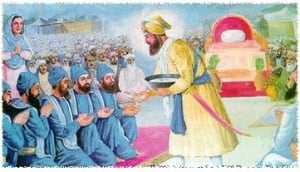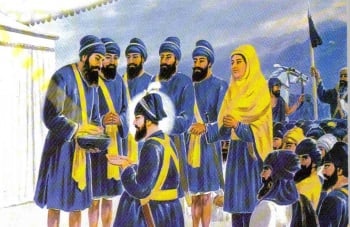Vaisakhi 1699

Guru Gobind Rai was 33 years old when he had Divine inspiration to actuate his designs. In early 1699, months before Baisakhi Day, Guru Gobind Rai sent special edicts to congregations far and wide telling all the Sangats (Sikh communities) that that year's Baisakhi was going to be a unique affair. He asked them not to cut any of their hair — to come with unshorn hair under their turbans and chunis, and for the men to come with full beards.
The Guru wanted to instil the principles of courage and morality in his downtrodden followers. He wanted to uplift their determination to combat the evil forces of injustice, tyranny, and oppression. He had become Guru with the criteria of courage and strength to sacrifice. Every year at the time of Baisakhi (springtime), thousands of devotees would come to Anandpur to pay their obeisance and seek the Guru's blessings.
The Khalsa initiation ceremony
On Baisakhi Day, April 14, 1699, hundreds of thousands of people gathered around his divine temporal seat at Anandpur Sahib. The Guru addressed the congregants with a most stirring oration on his divine mission of restoring their faith and preserving the Sikh religion.
After his inspirational discourse, he flashed his unsheathed sword and said that every great deed was preceded by an equally great sacrifice: Then calling out to the assembled crowd, 'My sword is hungry for a head', He demanded one head for oblation. After some trepidation one person offered himself for the Guru's 'great sacrifice'. The Guru took him inside a tent.
A little later the Guru came out of the tent, his sword dripping with fresh blood only to ask for another head. One by one four more earnest devotees offered their heads. Every time the Guru took a person inside the tent, he came out with his sword dripping fresh blood.
Thinking their Guru had gone mad and afraid that he would ask for more heads, some of the congregation started to disperse. Then, suddenly the Guru emerged with all five men dressed piously in white and in a new ceremony that changed the way in which one became a Sikh.
Panj Pyare
The Guru now initiated the five into a new and unique order of Sikhs. The ceremony was called pahul; which Sikhs today know as the baptism ceremony or Amrit Shakna. Then the Guru asked the first five Khalsa Sikhs to baptise him, in the same manner. He later proclaimed that the Panj Pyare -- the Five Beloved Ones -- would be the embodiment of the Guru himself:
- "Where there are Panj Pyare, there am I. When the Five meet, they are the holiest of the holy."
And so, as it was carried out on that historic day, the ceremony of Pahul continues to this day.
The important thing to remember about that day is that the five volunteers and the whole sangat thought or were "under the impression" that the five Sikhs were really walking to their deaths--being killed, one by one. The Sikhs who volunteered, had demonstrated their willingness to give their heads--in the same way that Guru Tegh Bahadur had done in Delhi.
The Guru's bit of showmanship, his seemingly--all to real test, was performed to prove the devotion and dedication of his Sikhs. Those who were ready to give themselves up to their Guru were the bravest and most devoted.
These brave men had unknowingly chosen to be part of a new 'panth' (path or way) - the Khalsa Panth. Guru ji joined the Khalsa Panth after his devoted Sikhs - the initiator becoming the initiated. Today, as then, they lead the Khalsa alongside the Guru:
- "Where there are Panj Pyare, there am I…"
Khalsa initiation ceremony - Amrit Sanchar
- Main article: Amrit Sanchar
He said whenever and wherever five baptised (Amritdhari) Sikhs come together, the Guru would be present. All those who receive Amrit from five baptized Sikhs will be infused with the spirit of courage and strength to sacrifice. Thus with these principles he established Panth Khalsa, the Order of the Pure Ones.
The Bana and Five Kakkar
- Main article: 5Ks
At the same time the Guru gave his new Khalsa a unique, indisputable, and distinct identity. The Guru gave the gift of bana, the distinctive Sikh clothing and headwear. He also offered five emblems of purity and courage.
These symbols, worn by all baptised Sikhs of both sexes, are popularly known today as Five Ks: Kesh, unshorn hair; Kangha, the wooden comb; Karra, the iron (or steel) bracelet; Kirpan, the sword; and Kachera, the underwear. By being identifiable, no Sikh could never hide behind cowardice again.
Political tyranny was not the only circumstance that was lowering peoples' morale. Discriminatory class distinctions (--the Indian "caste" system--) promoted by Brahmins and Mullahs was also responsible for the peoples' sense of degradation.
Unity for all
The Guru wanted to eliminate the anomalies caused by the caste system. The constitution of the Panj Pyare was the living example of his dream: both the high and low castes were amalgamated into one.
Among the original Panj Pyare, there was one Khatri, shopkeeper; one Jat, farmer; one Chhimba, calico printer/tailor; one Ghumar, water-carrier; and one Nai, a barber. The Guru gave the surname of Singh (Lion) to every Sikh and also took the name for himself. From Guru Gobind Rai he became Guru Gobind Singh.
He also pronounced that all Sikh women embody royalty, and gave them the surname Kaur (Princess). With the distinct Khalsa identity and consciousness of purity Guru Gobind Singh gave all Sikhs the opportunity to live lives of courage, sacrifice, and equality.
Celebration
The birth of the Khalsa is celebrated by Sikhs every Vaisakhi Day on April 13. Vaisakhi 1999 marks the 300th anniversary of Guru Gobind Singh's gift of Panth Khalsa to all Sikhs everywhere.
- WAHEGURU JI KA KHALSA, WAHEGURU JI KI FATEH!
See Also
- Vaisakhi
- Significance of Vaisakhi
- Vaisakhi 1699 Quotes
- Europe remembers
- Sikh festivals
- Pahul
- Kurehat
External Links

